A New Decision Process for Choosing the Wind Resource Assessment Workflow with the Best Compromise between Accuracy and Costs for a Given Project in Complex Terrain
Abstract
:1. Introduction
1.1. The Choice of Wind Resource Assessment Tools and Workflows
1.2. Wind Resource Assessment in Complex Terrain
1.3. Assessing the Accuracy of Different Tools
1.3.1. Evaluation of CFD Tools
1.3.2. Evaluation of Wind Energy Tools
1.4. A Compromise between Accuracy and Cost
1.5. Decision Support Systems
1.6. Goal of This Work
2. Decision Process Design
2.1. Basic Concepts
- The decision process aims to provide a decision on the choice of optimal WRA workflow(s) for a given site for wind resource assessors;
- It includes a new method for the classification of site complexity;
- It involves an assessment of the expected accuracy AND expected costs of applying a range of possible WRA workflows to a given site;
- It includes an assessment of the AEP accuracy and costs, as well as the wind speed;
- It does not require the user to carry out any simulations in order to assess the site or the workflows;
- The estimation of the accuracy and costs of each workflow involve a simple estimation of the scores of various pre-defined and pre-weighted assessment criteria.
2.2. Description of Decision Process
2.2.1. Define Skill and Cost Score Parameters and Weightings
- Software costs: divide the total license and support costs by the number years of usage, and divide this by the number of projects carried out per year;
- Time to learn and training costs: sum the staff costs for learning the tool and training costs, divide this by the number of projects carried out per year and the estimated number of years of usage;
- Simulation set-up effort costs: record the number of hours needed to set up the simulations, multiply this by the hourly staff rate (for all calculated wind directions);
- Simulation run time costs; record the simulation run-time and the number of cores, and multiply this by the computational cost per core per hour (for all calculated wind directions);
- Post-processing effort costs: record the number of hours needed to post-process the results, multiply this by the hourly staff rate (for all calculated wind directions).
- Number of years of usage of the software (20);
- Number of projects per year (8);
- Staff hourly rate ($100/h);
- Computational cost per core per hour ($0.04/hour/core);
- Processor clock speed (2 GHz).
2.2.2. Calculate Weighted “Skill Score Before” Parameters for Each Model
2.2.3. Average the Weighted Parameters to Get “Skill Score Before”
2.2.4. Calculate Percentage “Skill Score Before” Relative to Maximum of All Models
2.2.5. Calculate Total “Costs Before” and “Costs After” for Each Model
2.2.6. Calculate Percentage “Cost Score Before” and “Cost Score After” Relative to Maximum of All Models
2.2.7. Calculate Percentage “Skill Score After”
2.2.8. Plot Relative Skill vs. Cost Scores Before and After
2.3. Classification of Site Complexity
- General terrain complexity—how steep are the slopes on average?
- General terrain complexity—how many slopes are there?
- Validation mast position—in how many 30° sectors is there a positive slope steeper than 30° less than 250 m away from the validation position in any direction?
- Surface roughness complexity—approximately how many different surface roughness regions are you using?
- Surface roughness—how rough is the surface in general?
- Atmospheric stability—what is the average value of the vertical temperature gradient? (if relevant);
- Atmospheric stability—are low-level jets present?
- Degree of turbulence—what is the approximate Reynolds number, calculated based on the input flow velocity and the distance from the inlet to the calibration met mast?
3. Decision Process Test and Demonstration
3.1. Sites and Workflows
- WF-1: WindPro: The industry-leading software suite for design and planning of wind farm projects (www.wasp.dk, accessed on 1 December 2021), containing several physical models to describe the wind climate and wind flow over different terrains. For horizontal and vertical extrapolation, WAsP uses a built-in linear flow model, which performs well for flat to moderately complex terrain.
- WF-2: WindSim: An industry software using a Computational Fluid Dynamics (CFD) model based on the PHOENICS code, a 3D Reynolds Averaged Navier Stokes (RANS) solver from the company CHAM.
- WF-3: ANSYS CFX: An all-purpose CFD software. In this work, ANSYS CFX (version 19.2) was applied using an Unsteady RANS approach in combination with the k- model, with several adaptations including an anelastic formulation using the Boussinesq approximation [35], additional terms in the momentum equation to describe the Coriolis force and a canopy model for forested areas [36].
- WF-4: Fluent RANS: ANSYS Fluent is a commercial CFD tool for modelling the flow in industrial applications and can be set up to solve the RANS equations, as well as for the Large Eddy Simulations (LES) or Detached Eddy Simulations (DES) approach. In this work, Fluent was first set up to solve the RANS equations with the SST k- turbulence model [37].
- WF-5: Fluent SBES: A technique within ANSYS Fluent called “Stress-Blended Eddy Simulation” (SBES) was applied. SBES is a new model that offers improved shielding of RANS boundary layers and a more rapid RANS-LES “transition”, amongst other things. The RANS results were used to initialise SBES, which was performed unsteadily with an adaptive time stepping procedure ensuring CFL <= 1. After an additional unsteady initialisation, the wind speeds were averaged over 10 min.
- WF-6: PALM: The model PALM is based on the non-hydrostatic, filtered, incompressible Navier-Stokes equations in Boussinesq-approximated form (an anelastic approximation is available as an option for simulating deep convection). Furthermore, an additional equation is solved for either the subgrid-scale turbulent kinetic energy using Large-Eddy Simulations (LES) (https://palm.muk.uni-hannover.de/trac/wiki/palm, accessed on 1 December 2021).
- WF-7: E-Wind: E-Wind solves the 3D RANS equations, with a modified k- turbulence closure. The governing equations are implemented in the open source toolbox OpenFOAM [2].
3.2. Test of Decision Process at Site 1
3.2.1. Skill vs. Costs Plots
3.2.2. Site Complexity Characterisation
3.2.3. Summary of Test of Decision Process
3.3. Demonstration of Decision Process at Sites 2–5
3.3.1. Skill vs. Cost Score Plots
3.3.2. Site Complexity Characterisation
4. Discussion
4.1. Dependency of Decision Process Quality on Site Complexity
4.2. Suggested Improvements
4.2.1. General Method
4.2.2. Skill Score “Before” Estimation
4.2.3. Cost Scores “Before” and “After”
4.2.4. Complex Terrain Classification
5. Conclusions
Author Contributions
Funding
Institutional Review Board Statement
Informed Consent Statement
Data Availability Statement
Acknowledgments
Conflicts of Interest
Appendix A
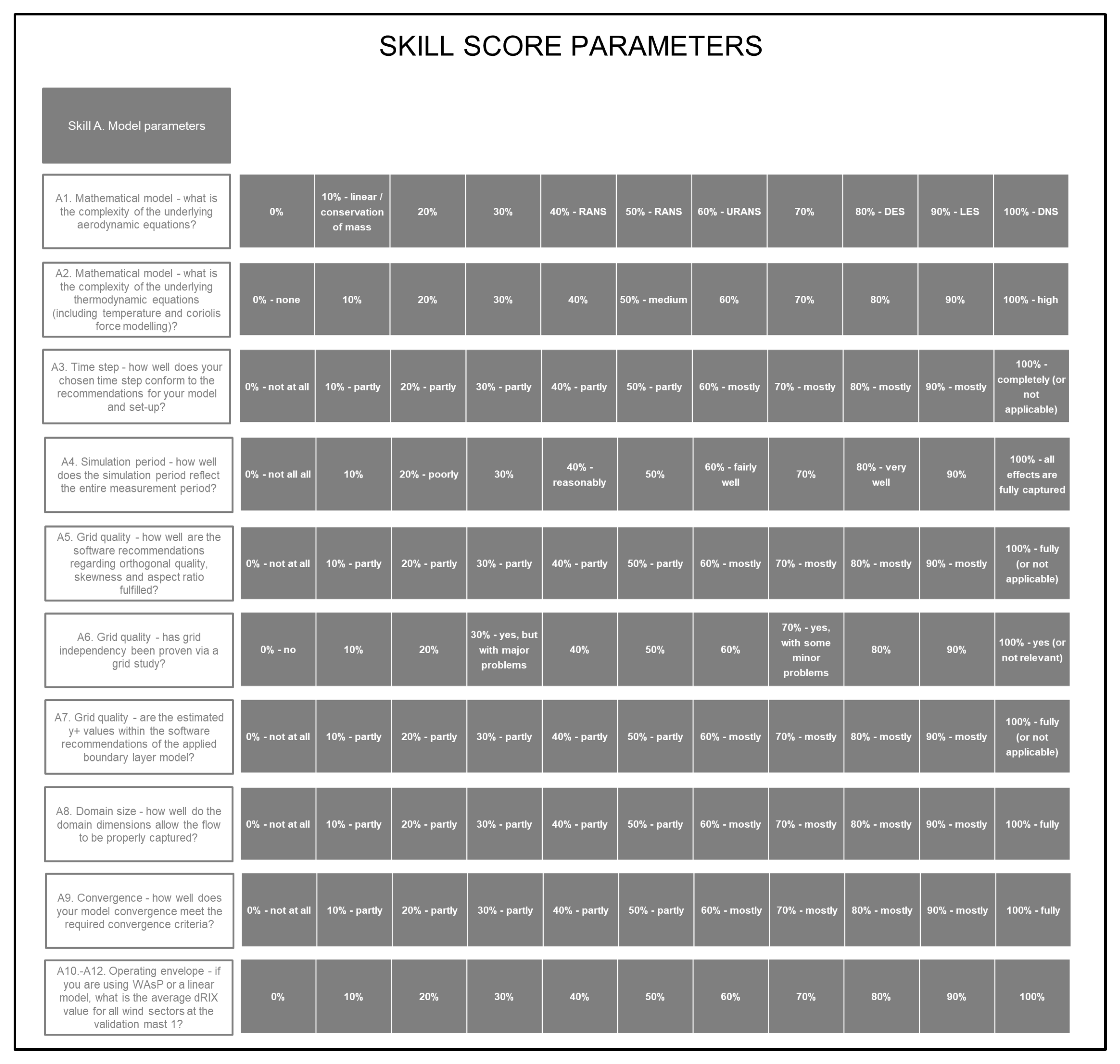
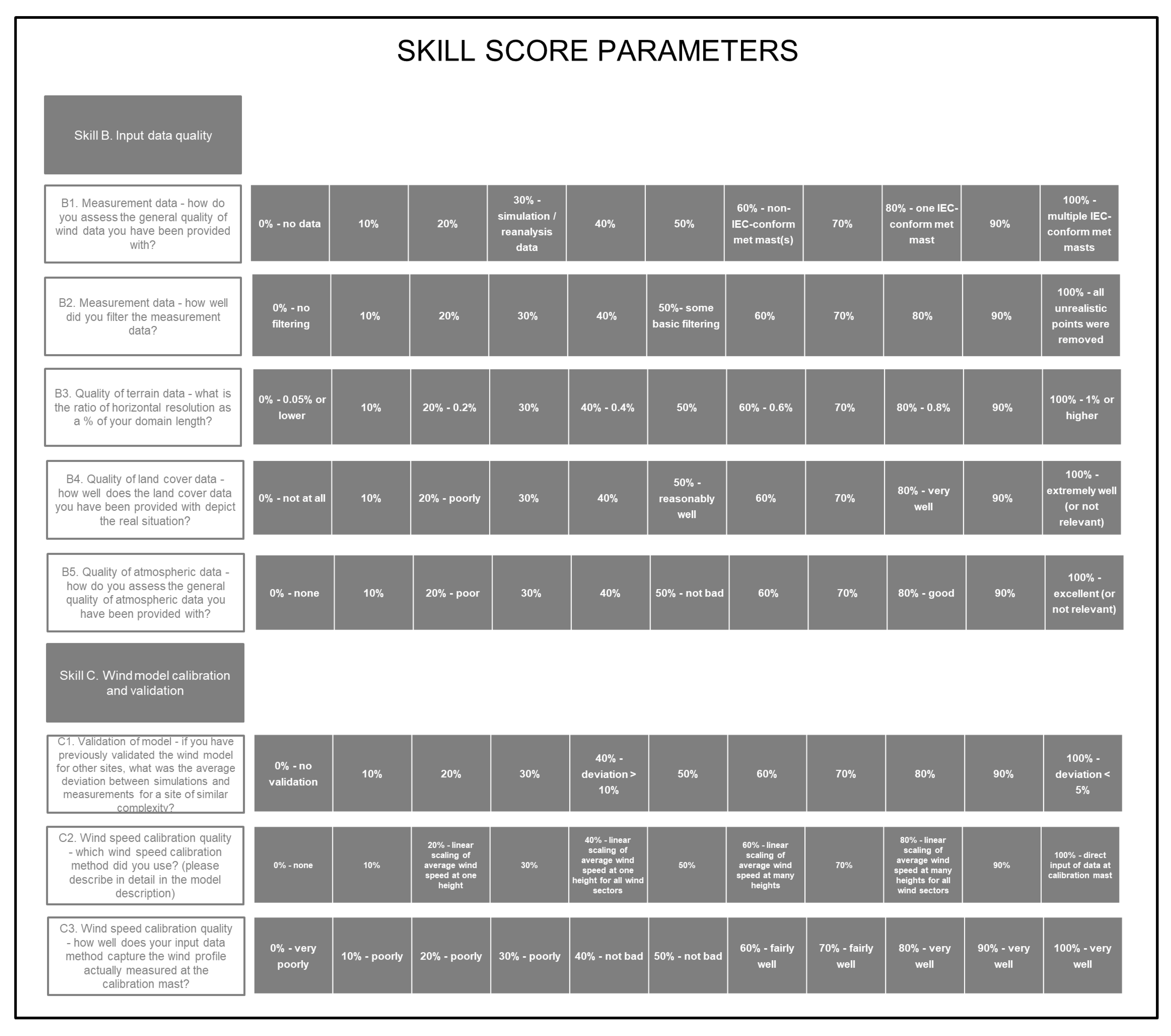
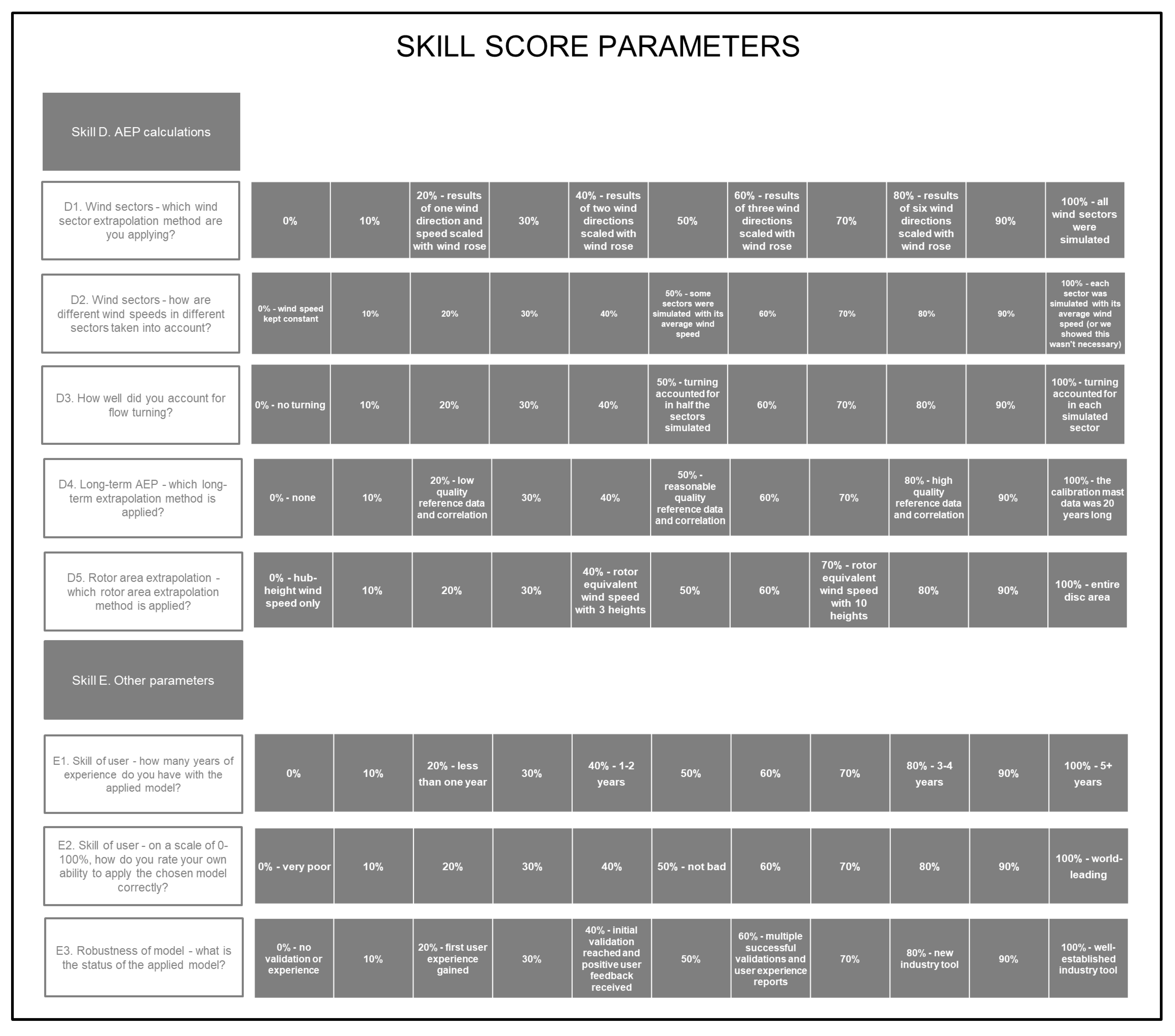
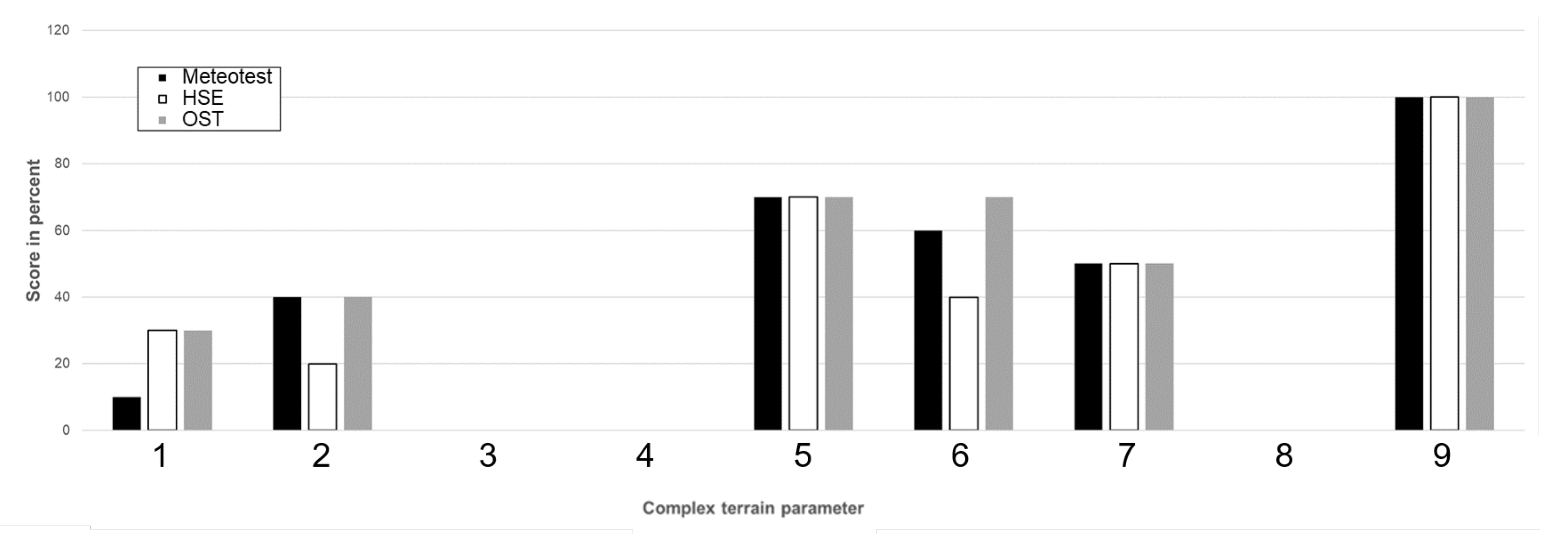

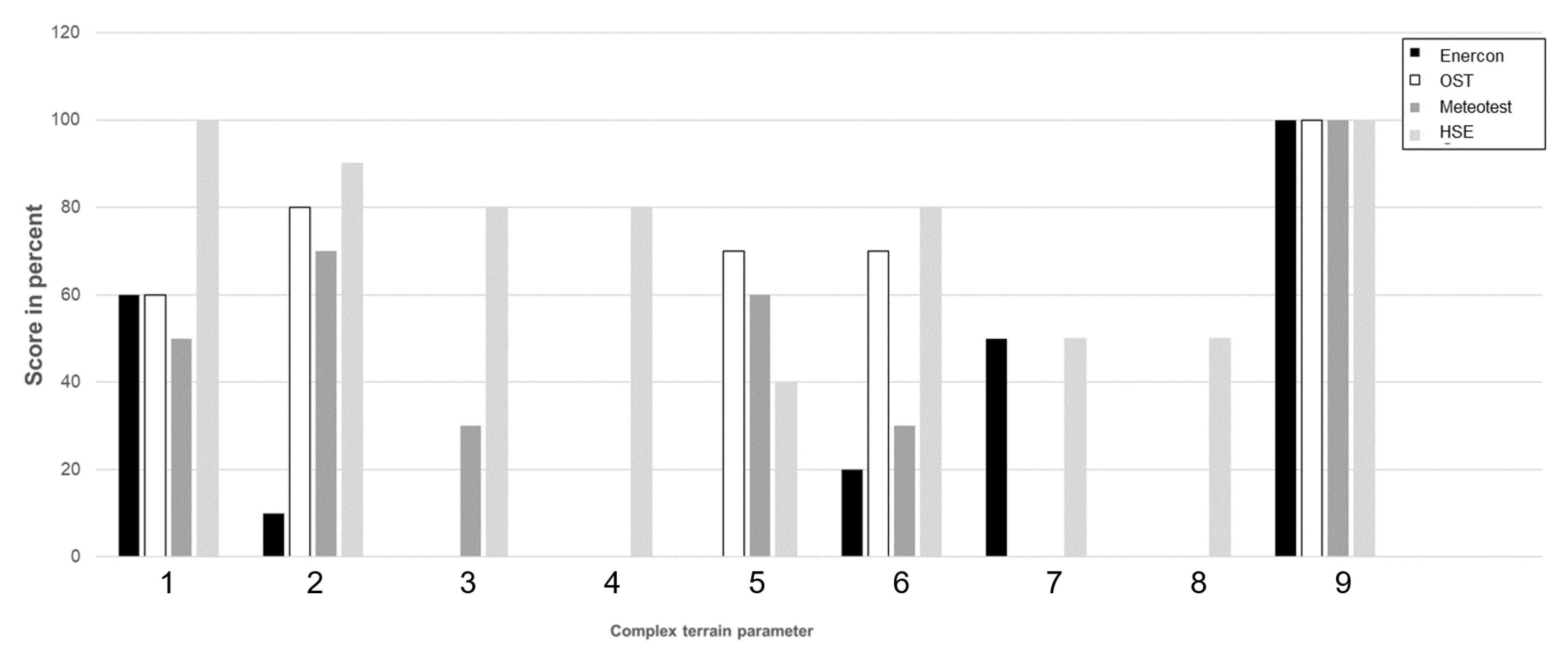
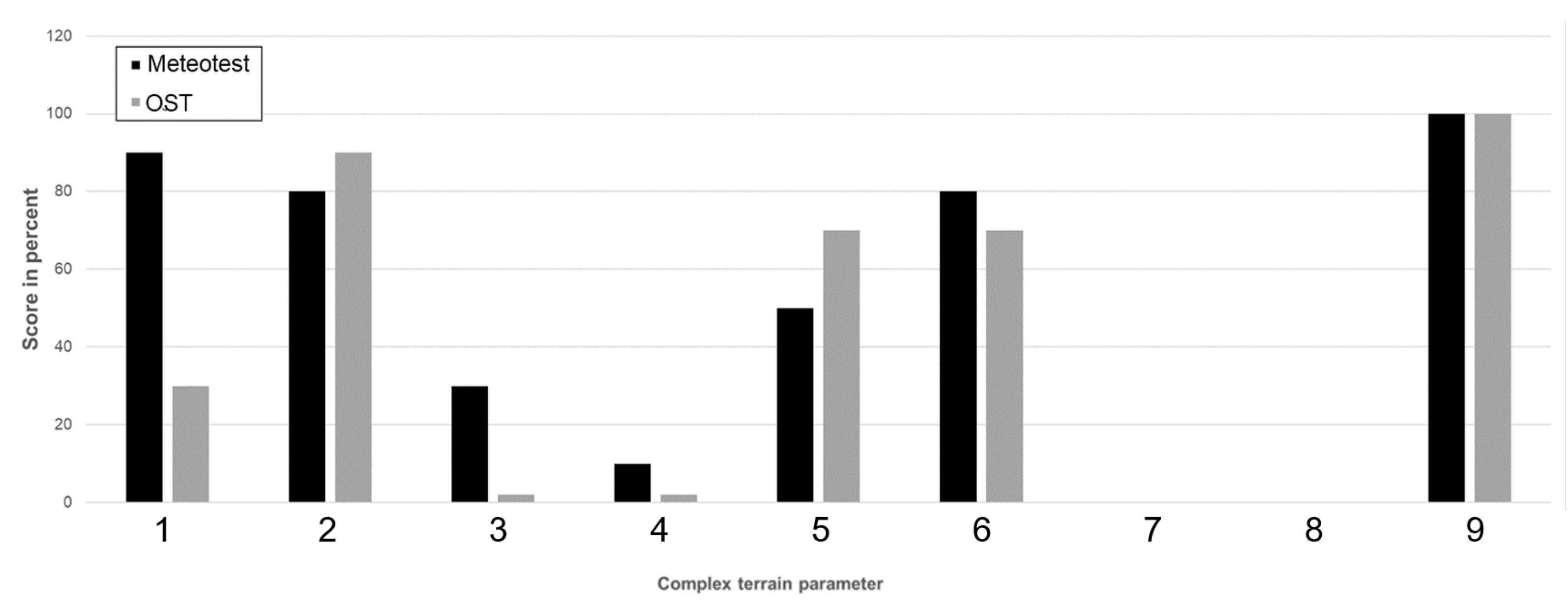
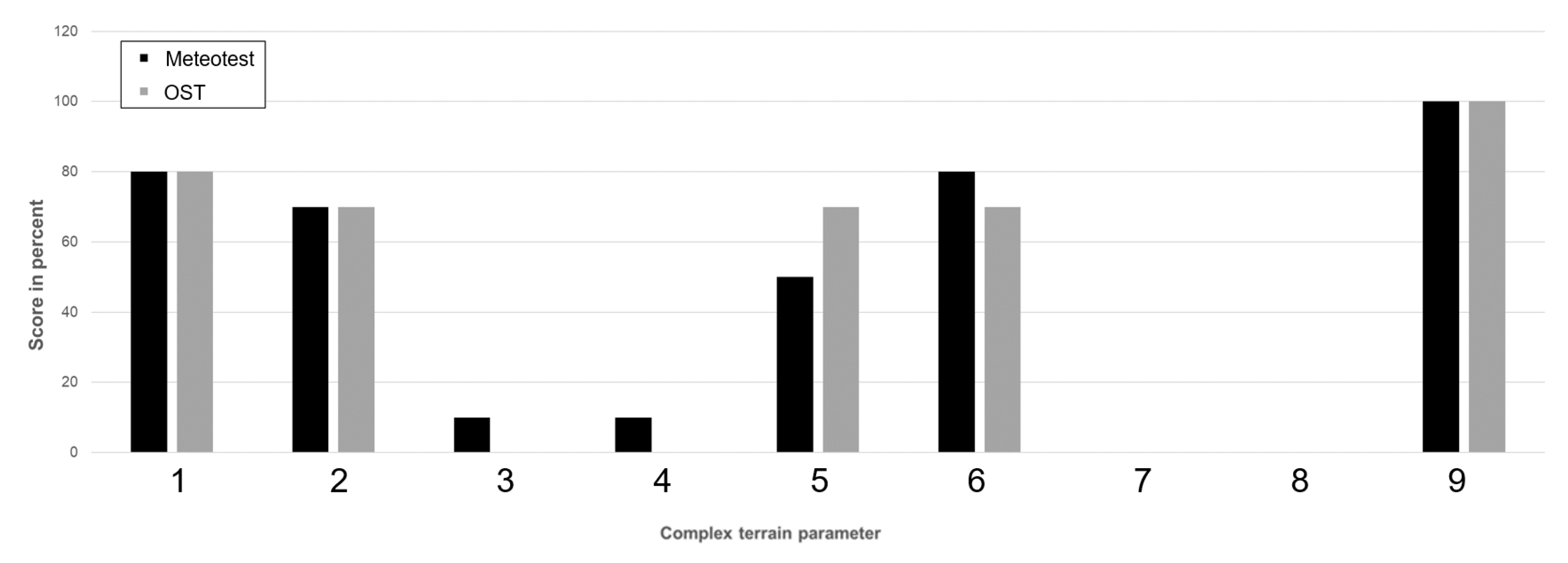
References
- Fördergesellschaft Windenergie. TR 6—Bestimmung von Windpotenzial und Energieerträgen; Fördergesellschaft Windenergie: Berlin, Germany, 2007. [Google Scholar]
- Alletto, M.; Radi, A.; Adib, J.; Langner, J.; Peralta, C.; Altmikus, A.; Letzel, M. E-Wind: Steady state CFD approach for stratified flows used for site assessment at Enercon. J. Phys. Conf. Ser. 2018, 1037, 072020. [Google Scholar] [CrossRef]
- Sayre, R.; Frye, C.; Karagulle, D.; Krauer, J.; Breyer, S.; Aniello, P.; Wright, D.J.; Payne, D.; Adler, C.; Warner, H.; et al. A New High-Resolution Map of World Mountains and an Online Tool for Visualizing and Comparing Characterizations of Global Mountain Distributions. Mt. Res. Dev. 2018, 38, 240–249. [Google Scholar] [CrossRef] [Green Version]
- Parish, T.R.; Cassano, J.J. The Role of Katabatic Winds on the Antarctic Surface Wind Regime. Mon. Weather Rev. 2003, 131, 317–333. [Google Scholar] [CrossRef]
- Bowen, A.J.; Mortensen, N.G. Exploring the limits of WAsP the wind atlas analysis and application program. In Proceedings of the European Union wind Energy Conference, Göteborg, Sweden, 20–24 May 1996; Zervos, A., Ehmann, H., Helm, P., Stephens, H.S., Eds.; H.S. Stephens & Associates: Bedford, UK, 1996. [Google Scholar]
- Wood, N. The onset of separation in neutral, turbulent flow over hills. Bound.-Layer Meteorol. 1995, 76, 137–164. [Google Scholar] [CrossRef]
- Pozo, J.M.; Geers, A.J.; Villa-Uriol, M.C.; Frangi, A.F. Flow complexity in open systems: Interlacing complexity index based on mutual information. J. Fluid Mech. 2017, 825, 704–742. [Google Scholar] [CrossRef]
- Britter, R.; Baklanov, A. (Eds.) Model Evaluation Guidance and Protocol Document: COST Action 732 Quality Assurance and Improvement of Microscale Meteorological Models; University of Hamburg Meteorological Inst: Hamburg, Germany, 2007. [Google Scholar]
- AIAA. Guide for the Verification and Validation of Computational Fluid Dynamics Simulations; AIAA: Reston, WV, USA, 1998. [Google Scholar]
- Daish, N.C.; Britter, R.E.; Linden, P.F.; Jagger, S.F.; Carissimo, B. SMEDIS: Scientific Model Evaluation of Dense Gas Dispersion Models. Int. J. Environ. Pollut. 2000, 14, 39–51. [Google Scholar] [CrossRef]
- VDI. VDI Guideline 3783, Part 9: Environmental Meteorology—Prognostic Microscale Windfield Models—Evaluation for Flow around Buildings and Obstacles; VDI Guideline 3783; Beuth Verlag GmbH: Berlin, Germany, 2005. [Google Scholar]
- Bechmann, A.; Sørensen, N.N.; Berg, J.; Mann, J.; Réthoré, P.E. The Bolund Experiment, Part II: Blind Comparison of Microscale Flow Models. Bound.-Layer Meteorol. 2011, 141, 245–271. [Google Scholar] [CrossRef] [Green Version]
- Berg, J.; Mann, J.; Bechmann, A.; Courtney, M.S.; Jørgensen, H.E. The Bolund Experiment, Part I: Flow Over a Steep, Three-Dimensional Hill. Bound.-Layer Meteorol. 2011, 141, 219–243. [Google Scholar] [CrossRef] [Green Version]
- Bao, J.; Chow, F.K.; Lundquist, K.A. Large-Eddy Simulation over Complex Terrain Using an Improved Immersed Boundary Method in the Weather Research and Forecasting Model. Mon. Weather Rev. 2018, 146, 2781–2797. [Google Scholar] [CrossRef]
- Menke, R.; Vasiljević, N.; Mann, J.; Lundquist, J.K. Characterization of flow recirculation zones at the Perdigão site using multi-lidar measurements. Atmos. Chem. Phys. 2019, 19, 2713–2723. [Google Scholar] [CrossRef] [Green Version]
- Barber, S.; Buehler, M.; Nordborg, H. IEA Wind Task 31: Design of a new comparison metrics simulation challenge for wind resource assessment in complex terrain Stage 1. J. Phys. Conf. Ser. 2020, 1618, 062013. [Google Scholar] [CrossRef]
- Lee, J.C.Y.; Fields, M.J. An overview of wind-energy-production prediction bias, losses, and uncertainties. Wind. Energy Sci. 2021, 6, 311–365. [Google Scholar] [CrossRef]
- Mortensen, N.; Nielsen, M.; Ejsing Jørgensen, H. Comparison of Resource and Energy Yield Assessment Procedures 2011–2015: What have we learned and what needs to be done? In Proceedings of the European Wind Energy Association Annual Conference and Exhibition 2015 (EWEA 2015), Paris, France, 17–20 November 2015. [Google Scholar]
- Barber, S.; Schubiger, A.; Koller, S.; Eggli, D.; Radi, A.; Rumpf, A.; Knaus, H. The wide range of factors contributing to Wind Resource Assessment accuracy in complex terrain. Wind. Energy Sci. 2021. [Google Scholar] [CrossRef]
- Barber, S.; Schubiger, A.; Koller, S.; Rumpf, A.; Knaus, H.; Nordborg, H. Actual Total Cost reduction of commercial CFD modelling tools for Wind Resource Assessment in complex terrain. J. Phys. Conf. Ser. 2020, 1618, 062012. [Google Scholar] [CrossRef]
- Yu, M.C.; Kuncel, N.R. Pushing the Limits for Judgmental Consistency: Comparing Random Weighting Schemes with Expert Judgments. Pers. Assess. Decis. 2020, 6, 2. [Google Scholar] [CrossRef]
- Hogarth, R.; Karelaia, N. Heuristic and linear models of judgment: Matching rules and environments. Psychol. Rev. 2007, 114, 733–758. [Google Scholar] [CrossRef] [Green Version]
- Grove, W.; Zald, D.; Lebow, B.; Snitz, B.; Nelson, C. Clinical versus mechanical prediction: A meta-analysis. Psychol. Assess. 2000, 12, 19–30. [Google Scholar] [CrossRef]
- Goldberg, L. Man versus model of man: A rationale, plus some evidence, for a method of improving on clinical inferences. Psychol. Bull. 1970, 73, 422. [Google Scholar] [CrossRef] [Green Version]
- Dawes, R.; Corrigan, B. Linear models in decision making. Psychol. Bull. 1974, 81, 95–106. [Google Scholar] [CrossRef]
- Dana, J.; Dawes, R.M. The superiority of simple alternatives to regression for social science predictions. J. Educ. Behav. Stat. 2004, 29, 317–331. [Google Scholar] [CrossRef]
- Wainer, H. Estimating coefficients in linear models: It don’t make no nevermind. Psychol. Bull. 1976, 83, 213. [Google Scholar] [CrossRef]
- Kumar, A.; Sah, B.; Singh, A.R.; Deng, Y.; He, X.; Kumar, P.; Bansal, R. A review of multi criteria decision making (MCDM) towards sustainable renewable energy development. Renew. Sustain. Energy Rev. 2017, 69, 596–609. [Google Scholar] [CrossRef]
- Malkawi, A.M.; Srinivasan, R.S.; Yi, Y.K.; Choudhary, R. Decision support and design evolution: Integrating genetic algorithms, CFD and visualization. Autom. Constr. 2005, 14, 33–44. [Google Scholar] [CrossRef]
- Nikpour, M.; Mohebbi, A. Optimization of micromixer with different baffle shapes using CFD, DOE, meta-heuristic algorithms and multi-criteria decision making. Chem. Eng. Process.-Process Intensif. 2022, 170, 108713. [Google Scholar] [CrossRef]
- Wagg, D.J.; Worden, K.; Barthorpe, R.J.; Gardner, P. Digital Twins: State-of-the-Art and Future Directions for Modeling and Simulation in Engineering Dynamics Applications. ASCE-ASME J. Risk Uncert Eng. Syst. Part B Mech. Eng. 2020, 6, 030901. [Google Scholar] [CrossRef]
- Ribeiro, J.; Carmona, J.; Mısır, M.; Sebag, M. A Recommender System for Process Discovery. In Business Process Management, Proceedings of the International Conference on Business Process Management, Eindhoven, The Netherlands, 7–11 September 2014; Sadiq, S., Soffer, P., Völzer, H., Eds.; Springer International Publishing: Cham, Switzerland, 2014; pp. 67–83. [Google Scholar]
- Kapteyn, M.G.; Pretorius, J.V.R.; Willcox, K.E. A probabilistic graphical model foundation for enabling predictive digital twins at scale. Nat. Comput. Sci. 2021, 1, 337–347. [Google Scholar] [CrossRef]
- Andriotis, C.P.; Papakonstantinou, K.G.; Chatzi, E.N. Value of structural health information in partially observable stochastic environments. Struct. Saf. 2021, 93, 102072. [Google Scholar] [CrossRef]
- Montavon, C. Validation of a non-hydrostatic numerical model to simulate stratified wind fields over complex topography. J. Wind. Eng. Ind. Aerodyn. 1998, 74–76, 273–282. [Google Scholar] [CrossRef]
- Liu, J.; Chen, J.M.; Black, T.A.; Novak, M.D. E-ϵ modelling of turbulent air flow downwind of a model forest edge. Bound.-Layer Meteorol. 1996, 77, 21–44. [Google Scholar] [CrossRef]
- Menter, F. Zonal Two Equation k-w Turbulence Models For Aerodynamic Flows. In Proceedings of the 23rd Fluid Dynamics, Plasmadynamics, and Lasers Conference, Orlando, FL, USA, 6–9 July 2012. [Google Scholar]
- Einhorn, H.J.; Hogarth, R.M. Unit weighting schemes for decision making. Organ. Behav. Hum. Perform. 1975, 13, 171–192. [Google Scholar] [CrossRef]
- Barber, S.; Schubiger, A.; Koller, S.; Eggli, D.; Rumpf, A.; Knaus, H. A new process for the pragmatic choice of wind models in complex terrainSource—Final report. East. Switz. Univ. Appl. Sci. 2021. Available online: https://drive.switch.ch/index.php/s/DGxWeKQ35nnbPMW (accessed on 1 December 2021).

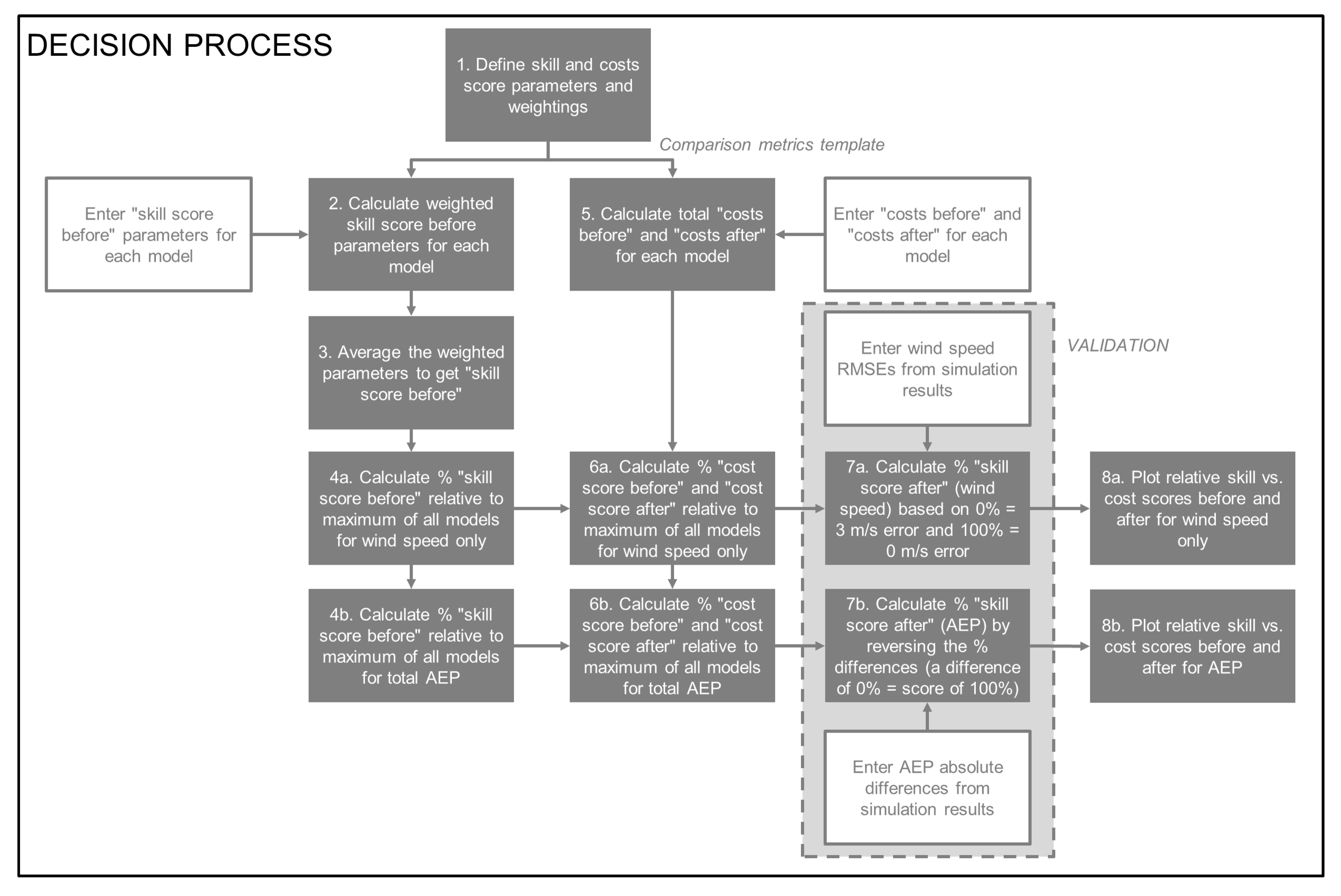

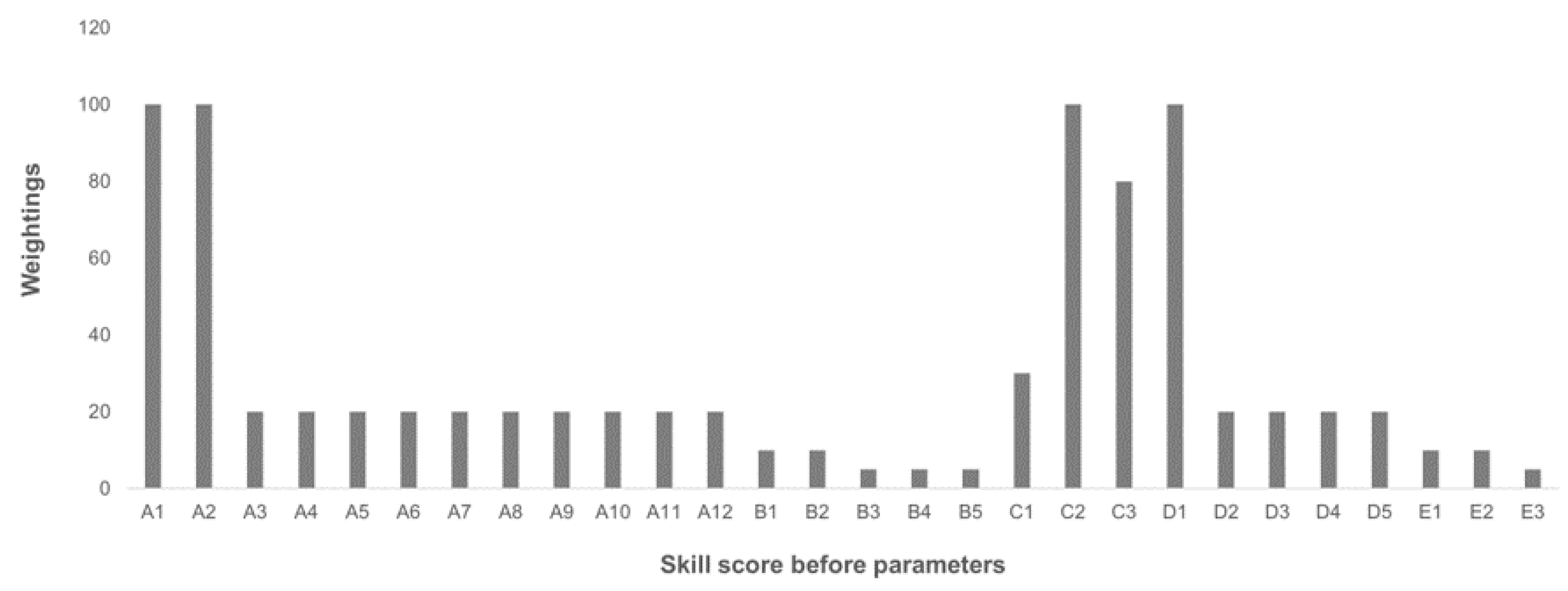
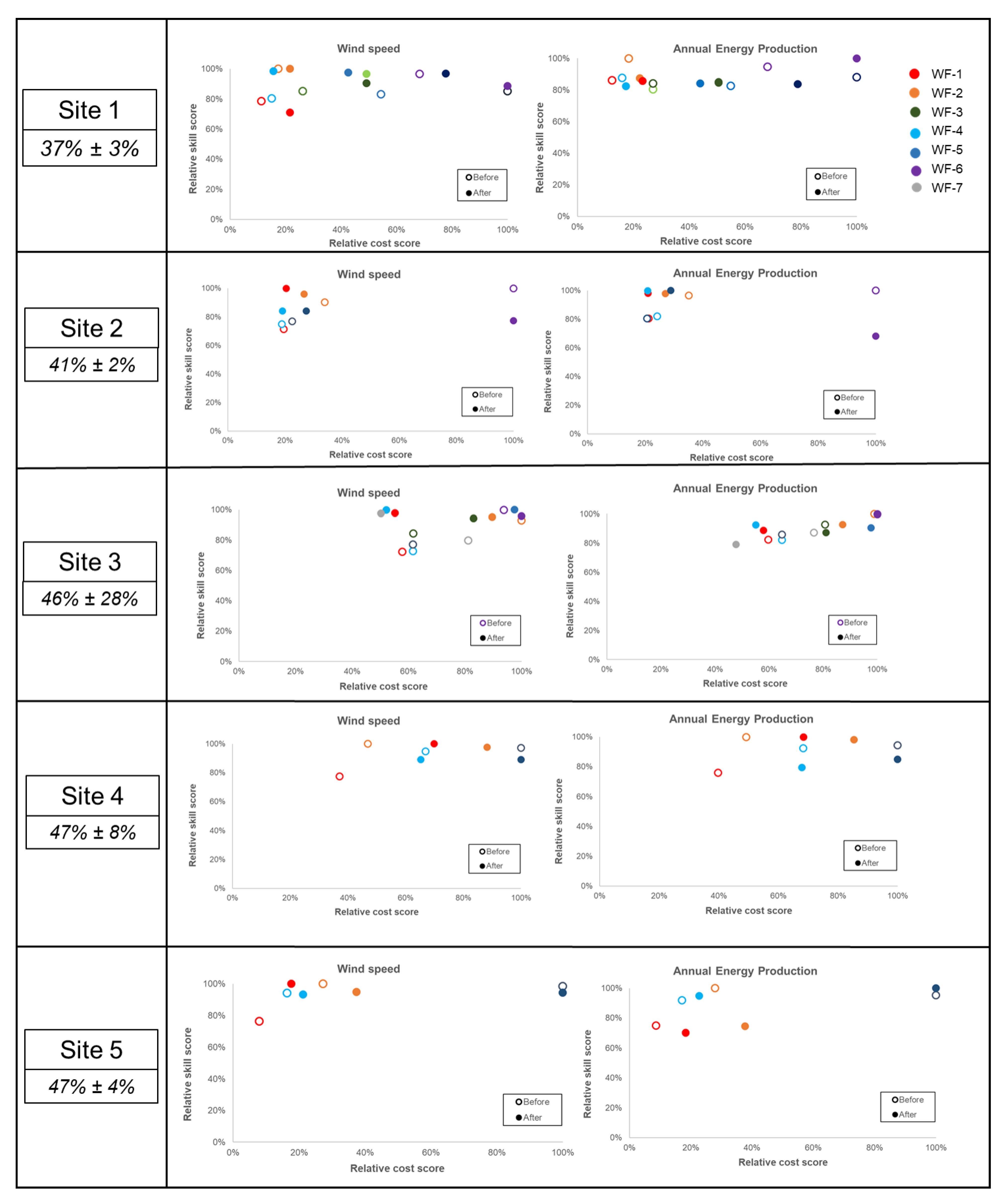
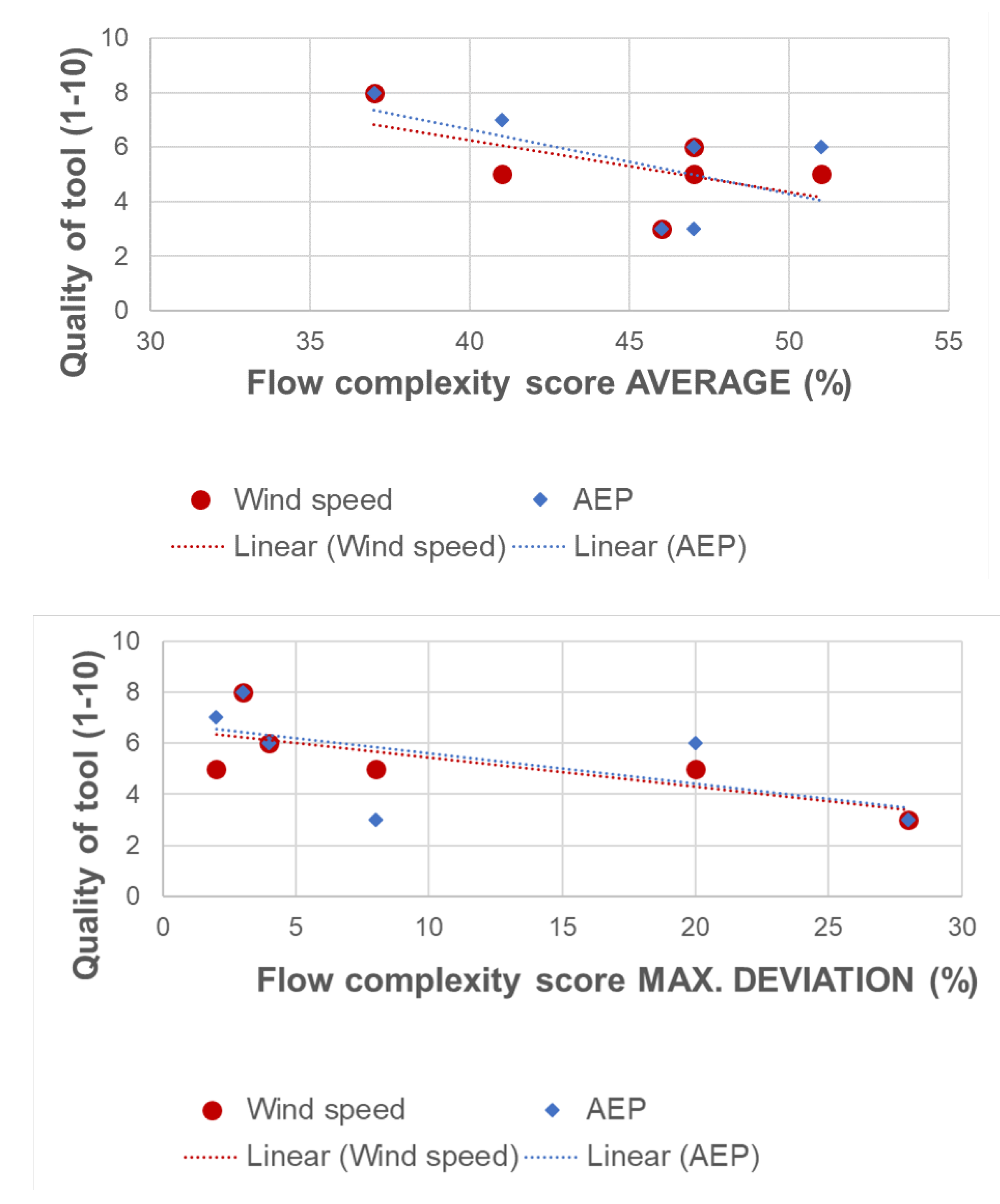
| Organisation | Score Site 1 | Score Site 2 | Score Site 3 | Score Site 4 | Score Site 5 |
| Meteotest | 37 | 43 | 43 | 55 | 50 |
| HSE | 34 | 43 | 74 | - | 43 |
| OST | 40 | 38 | 42 | 40 | - |
| Enercon | - | - | 27 | - | - |
| Average | 37 | 41 | 46 | 47 | 47 |
| Standard deviation | 3 | 2 | 28 | 8 | 4 |
Publisher’s Note: MDPI stays neutral with regard to jurisdictional claims in published maps and institutional affiliations. |
© 2022 by the authors. Licensee MDPI, Basel, Switzerland. This article is an open access article distributed under the terms and conditions of the Creative Commons Attribution (CC BY) license (https://creativecommons.org/licenses/by/4.0/).
Share and Cite
Barber, S.; Schubiger, A.; Koller, S.; Eggli, D.; Radi, A.; Rumpf, A.; Knaus, H. A New Decision Process for Choosing the Wind Resource Assessment Workflow with the Best Compromise between Accuracy and Costs for a Given Project in Complex Terrain. Energies 2022, 15, 1110. https://doi.org/10.3390/en15031110
Barber S, Schubiger A, Koller S, Eggli D, Radi A, Rumpf A, Knaus H. A New Decision Process for Choosing the Wind Resource Assessment Workflow with the Best Compromise between Accuracy and Costs for a Given Project in Complex Terrain. Energies. 2022; 15(3):1110. https://doi.org/10.3390/en15031110
Chicago/Turabian StyleBarber, Sarah, Alain Schubiger, Sara Koller, Dominik Eggli, Alexander Radi, Andreas Rumpf, and Hermann Knaus. 2022. "A New Decision Process for Choosing the Wind Resource Assessment Workflow with the Best Compromise between Accuracy and Costs for a Given Project in Complex Terrain" Energies 15, no. 3: 1110. https://doi.org/10.3390/en15031110
APA StyleBarber, S., Schubiger, A., Koller, S., Eggli, D., Radi, A., Rumpf, A., & Knaus, H. (2022). A New Decision Process for Choosing the Wind Resource Assessment Workflow with the Best Compromise between Accuracy and Costs for a Given Project in Complex Terrain. Energies, 15(3), 1110. https://doi.org/10.3390/en15031110






